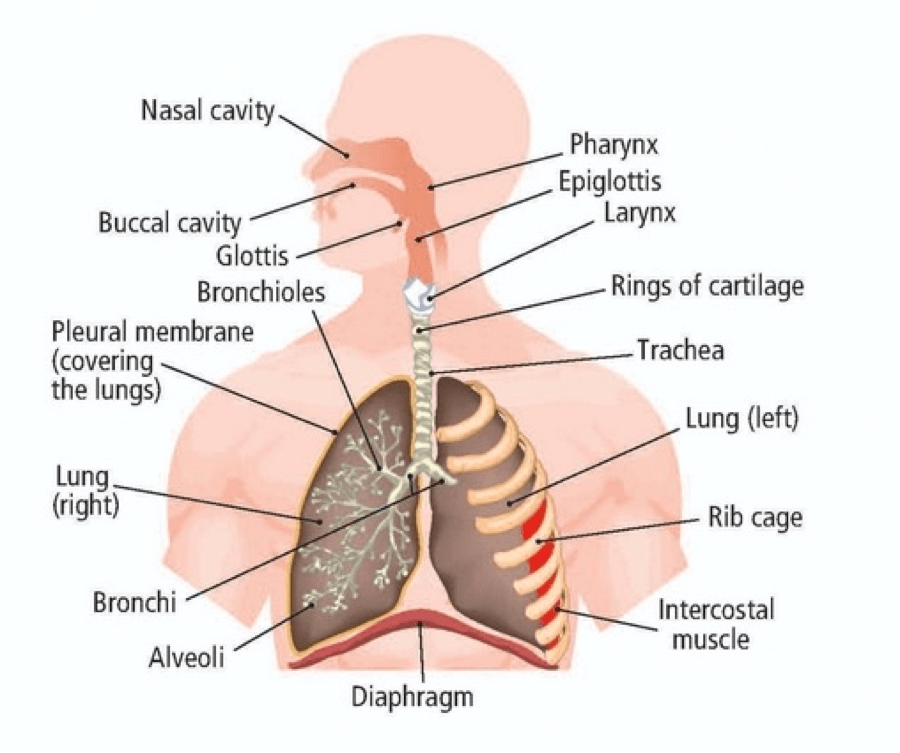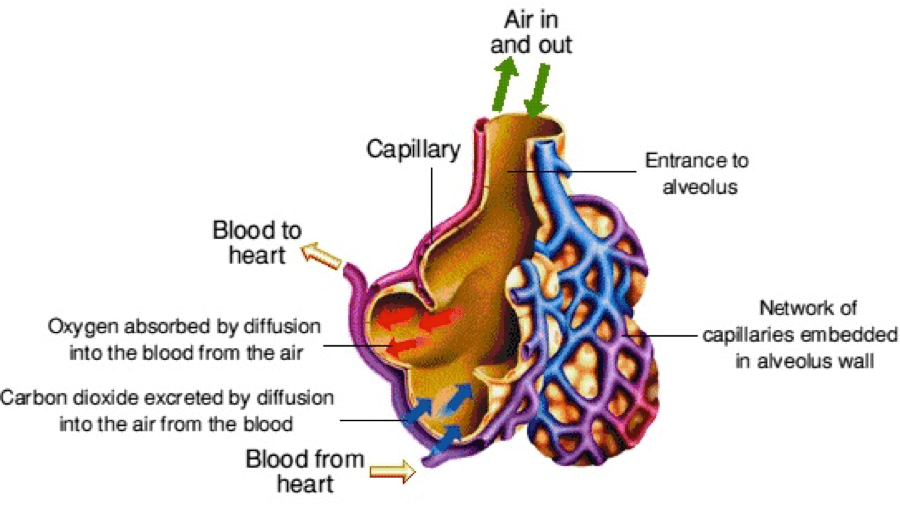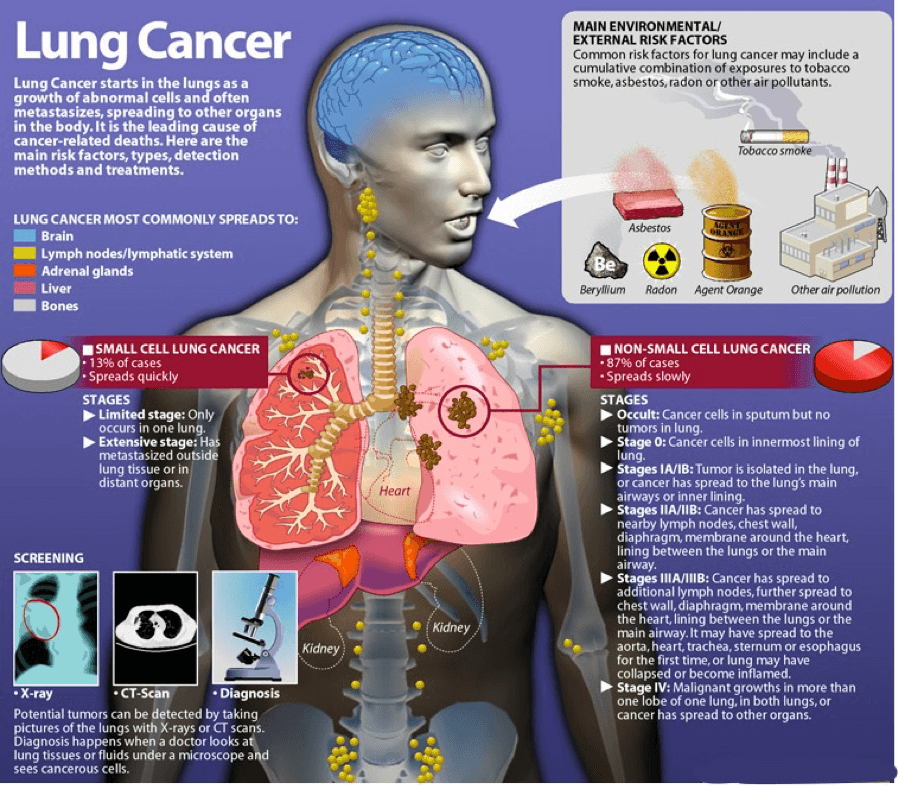The human respiratory system allows one to obtain oxygen and to eliminate carbon dioxide.
The breathing consists of two phases, inspiration and expiration.
- Inspiration is the process of taking in air (O2)
- Expiration is the process of blowing out air (CO2)

Organs of the Respiratory System:
- Nose / nasal cavity
Its function is to warm, moisten and filter air as it is inhaled.
- Pharynx (throat)
The pharynx is the passage way for air, leading to the trachea.
- Larynx
The larynx is the voice box, where vocal cords are located.
- Trachea (windpipe)
The trachea is lined with fine hairs called cilia, which filter air before it reaches the lungs.
- Bronchi
There are two branches at the end of the trachea, each lead to a lung.
- Bronchioles
Bronchioles are a network of smaller branches leading from the bronchi into the lung tissue and ultimately to air sacs.
- Alveoli
Alveoli are the functional respiratory units in the lung, where gases are exchanged. Each alveoli is surrounded by a network of tiny blood vessels called capillaries. Blood from the capillaries picks up oxygen from the alveoli and releases carbon dioxide to be exhaled. Each lung has about 150 million alveoli.

Respiration consists of 4 distinct processes:
- Pulmonary Ventilation
- moving air into and out of the lungs.
- diaphragm and intercostals muscles promote ventilation
- External Respiration
- diffusion of gases between the alveoli and the blood of the pulmonary capillaries.
- Transport
- transport of oxygen and carbon dioxide between the lungs and tissues
- Internal Respiration
- diffusion of gases between the blood of the systemic capillaries and cells.
Breathing
Inspiration
Inspiration (or inhalation) is the result of increase in the size of thoracic cavity
- The diaphragm and external intercostal muscles (inspiratory muscles) contract and the rib cage rises, stretching the lungs and increasing intrapulmonary volume.
- As the diaphragm flattens, it presses the organs inside the abdomen and with the abdominal muscles relaxed, the abdominal wall moves outwards. When the thoracic (chest) cavity increases in size, its internal pressure is decreased.
- Intrapulmonary pressure drops below atmospheric pressure (1 mm Hg) drawing air flow into the lungs, down its pressure gradient, until intrapleural pressure = atmospheric pressure.
The outside air, which is at a greater pressure, rushes in to equalize the pressure.
Expiration
Expiration (or exhalation) is the result of reverse movements of the ribs and diaphragm.
- Inspiratory muscles relax and the rib cage descends due to gravity, elasticity.
- Thoracic cavity volume decreases, elastic lungs recoil passively and intrapulmonary volume decreases.
- Intrapulmonary pressure rises above atmospheric pressure (+1 mm Hg), gases flow out of the lungs down the pressure gradient until intrapulmonary pressure is 0
- As a consequence of the above–mentioned movements of ribs and diaphragm, the cavity of the thorax is diminished and the lungs are compressed, forcing the air out into the atmosphere.

The respiratory cycle consists of one inspiration followed by one expiration. The volume of air that enters or leaves during a single respiratory cycle is called the tidal volume. Tidal volume is typically 500 milliliters, meaning that 500 milliliters of air enters during inspiration and the same amount leaves during expiration.
In normal adults, the breathing rate is 12–18 breaths per minute. A newborn breathes 60 times per minute. It is always 4–5 times less than heart rate. Slight increase in CO2 content in blood increases breathing rate.
Diseases of the lung
Asthma
In asthma, small muscles in the bronchioles contract in response to contact with an allergen, a virus or bacterial infection, or stress. The constriction of the muscles narrows the airways, which means that sufferers can’t get enough air out.
Bronchitis
Bronchitis is inflammation of the mucous membrane in the bronchial tubes. It typically causes bronchospasm and coughing. Bronchitis can be due to an infection (viral, bacterial), smoking or breathing in irritating substances (smoke, dust, toxic fumes)
Emphysema
Emphysema is a condition in which the alveoli deteriorate, causing the lungs to lose their elasticity.
Pneumonia
Pneumonia is caused by the bacteria pneumococcus. A condition in which the alveoli become filled with fluid and therefore preventing the exchange of gases.
Pulmonary edema
In a pulmonary edema fluid is accumulating in interstitial space increases diffusion distance. This leads to impaired gas exchange and may cause respiratory failure.
Pulmonary fibrosis
Pulmonary fibrosis refers to scarring of lung tissue, leading to serious breathing problems.
Smoking
Smoking causes permanent damage to the lung function. Cigarette smoke contains many chemicals that interfere with the body's method of filtering air and cleaning out the lungs. The smoke irritates the lungs and leads to overproduction of mucus. It also paralyses the cilia - tiny hair-like structures that line the airways and clean out dust and dirt.
This extra mucus means smokers are more likely to suffer from chronic bronchitis and what is known as 'smoker's cough'.
Cigarette smoke is one of the best known triggers of asthma.
Lung cancer is the most common form of cancer caused by smoking. More than 80% of cases of lung cancer are due to smoking.

Typical symptoms of respiratory diseases:
- Fever / chills
- Mucus
- Shortness of breath
- Fatigue / weakness
- Cough / chest congestion
- Sore throat
- Chest pain
- General aches and pains
- Headache
- Nasal congestion
Causes of respiratory diseases:
- Cigarette smoking
- Diet
- Exercise
- Cystic fibrosis
- Medication / drugs
- Glutathione deficiency
- Deficiencies
- Gastrointestinal dysfunction
- Allergies
- Exercise
- Stress
- Increased infection risk
- Weakened immune system
- Surgery or trauma
- Other serious illnesses
- Toxins / Pollution / Environment
- Bacteria / Viruses / Fungi
Please refer to the Truly Heal Functional Medicine App (Respiratory System) for further explanations.
Specific tests for the respiratory system are found in the Laboratory chapter.
Natural treatments for respiratory diseases:
Finding and removing the cause!!!
The mentioned substances below assist in healing respiratory diseases. Refer to the app for further descriptions, dosages and research references.
- Immune Modulating (Zinc, Vitamin D, Vitamin C, selenium, lactoferrin, beta-glucans, Echinacea, probiotics, reishi mushroom)
- Mucolytic ( N-Acetylcysteine, serrapeptase, Grindelia squarrosa, proteolytic enzymes, Glycyrrhiza glabra, Eucalyptus)
- Anti-bacterial, anti-viral, anti-fungal (Garlic, elderberry, goldenroot, black cumin, thymus vulgaris, iodine, andrographic, L-Lysine)
- Connective tissue healing (Vitamin A and C, lysine, proline, zinc
- Antioxidants (Selenium, N-Acetylcysteine)
- Inflammation ( Quercetin, Boswellia serrata, Curcuma longa)
Recommended reading:
Article: Understanding Asthma and the root causes https://www.trulyheal.com/understanding-asthma-the-root-causes/
Article: Maintaining your Lung Health: https://www.trulyheal.com/maintaining-your-lung-health/
Further reading but not required:
Any Anatomy and Physiology textbook.
Book: “Clinical Naturopathy” by Jerome Sarris &Jon Wardle (Chapter Respiratory Diseases)
